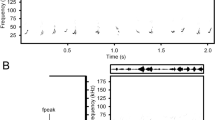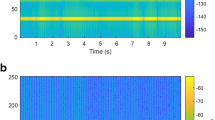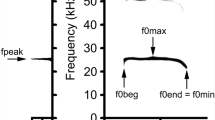Abstract
The worldwide presence of feral pigeons Columba livia domestica in urban habitats presents potential public health hazards from pathogens and parasites, and droppings can lead to damage to buildings. A variety of lethal and non-lethal chemical repellents, visual, sonic or mechanic measures are available to deter pigeons, but they are not always applicable or effective. Ultrasonic devices are one of the available possibilities with the advantage of being inaudible to humans and more or less harmless to animals. However, their utility is questionable, because the upper limit of frequencies heard by pigeons reported is well below that of ultrasound. We tested whether a commercially used ultrasound deterrent system has an effect on the behaviour of free-living, as well as caged feral pigeons and assessed whether ultrasound has a physiological effect, i.e. whether it can activate the hypothalamo-pituitary-adrenal-axis (HPA-axis) known to trigger flight behaviour. Our experimental tests did neither show any effect on the behaviour and the HPA-axis of the caged pigeons nor any deterring effect on the free-living pigeons. A habituation effect could not be detected. We therefore, conclude that ultrasound does not deter feral pigeons.



Similar content being viewed by others
References
Bassi M, Chiantante D (1976) The role of pigeon excrement in stone biodeterioration. Intern Biodeterior Bull 12:3
Beuter KJ, Weiss R (1986) Properties of the auditory systems in birds and the effectiveness of acoustic scaring signals. Meet Bird Strike Comm Eur 8:60–73
Bezzel E, Prinzinger R (1990) Ornithologie. Ulmer, Stuttgart
Bird-X http://www.bird-x.com
Bomford M (1990) Ineffectiveness of a sonic device for deterring starlings. Wildl Soc Bull 18:151–156
Bomford M, O’Brien PH (1990) Sonic deterrents in animal damage control: a review of device tests and effectiveness. Wildl Soc Bull 18:411–422
Boonstra R (2005) Equipped for life: the adaptive role of the stress axis in male mammals. J Mamm 86:236–247
Clark L (1998) Review of bird repellents. Proceedings of the 18th Vertebrate Pest Conference 329–337, http://www.digitalcommons.unl.edu/vpc18/6
Cockrem JF, Silverin B (2002) Sight of a predator can stimulate a corticosterone response in the Great Tit (Parus major). Gen Comp Endocrinol 125:248–255
Desostar GmbH (2013) www.desostar.com
Giunchi D, Albores-Barajas YV, Baldaccini NE, Vanni L, Soldatini C (2012) Feral pigeons: problems, dynamics and control methods. In: Soloneski S (ed), Integrated pest management and pest control—current and future tactics, InTech, Europe, pp 215–240
Griffith RE (1987) Efficacy testing of an ultrasonic bird repeller. In: Shumake SS, Bullard RW (eds). Vertebrate pest control and management materials, 5th vol. ASTM Spec Tech Publ 974, Philadelphia, pp 56–63
Haag-Wackernagel D (2000) Behavioural responses of the feral pigeon (Columbidae) to deterring systems. Folia Zool 49:101–114
Haag-Wackernagel D (2010) Taubenabwehr, Tierschutz – Verhalten – Wirkung. Universität Basel, Verlag Medizinische Biologie
Haag-Wackernagel D, Bircher AJ (2010) Ectoparasites from feral pigeons affecting humans. Dermatol 220:82–92
Haag-Wackernagel D, Moch H (2004) Health hazards posed by feral pigeons. J Infect 48:307–313
Haase E, Rees A, Harvey S (1986) Flight stimulates adrenocortical activity in pigeons (Columba livia). Gen Comp Endocrinol 61:424–427
Hamershock DM (1992) Ultrasonics as a method of bird control. Report. Flight Dynamics Directorate, Wright Laboratory, Wright-Patterson Air Force Base
Heldmaier G, Neuweiler G (2003) Vergleichende tierphysiologie. Springer, Berlin Heidelberg New York
Kéry M (2010) Introduction to WinBUGS for ecologists. Academic Press, Burlington
Mason JR (1997) Overview of controls: why they work and how they function. Repellents. In: Nolte DL, Wagner KK (eds) Wildlife damage management for natural resource managers. Western Forestry and Conservation Association, Portland, pp 11–16
Monclús R, Rödel HG, Von Holst D, De Miguel J (2005) Behavioural and physiological responses of naive European rabbits to predator odour. Anim Behav 70:753–761
Munro CJ, Lasley BL (1988) Non-radiometric methods for immunoassay of steroid hormones. In: Albertson BD, Haseltine FP (eds) Non-radiometric assays: technology and application in polypeptide and steroid hormone detection. Liss, New York, pp 289–329
Munro CJ, Stabenfeldt G (1984) Development of a microtitre plate enzyme immunoassay for the determination of progesterone. J Endocrinol 101:41–49
Plummer M (2003) JAGS: A Program for analysis of Bayesian graphical models using gibbs sampling. Proceedings of the 3rd Internnational Workshop on Distributed Statistical Computing (DSC 2003)
R Core Team (2012): R: a language and environment for statistical computing. R Foundation for Statistical Computing, Vienna, Austria. ISBN 3-900051-07-0, URL http://www.R-project.org
Rees A, Harvey S (1987) Adrenocortical responses of pigeons (Columba livia) to treadwheel exercise. Gen Comp Endocrinol 65:117–120
Romero LM, Reed JM (2005) Collecting baseline corticosterone samples in the field: Is under 3 min good enough? Comp Biochem Physiol 140:73–79
Sapolsky RM, Romero LM, Munck AU (2000) How do glucocorticoids influence stress responses? Integrating permissive, suppressive, stimulatory and preparative actions. Endocr Rev 21:55–89
Schulkin J, Morgan MA, Rosen JB (2005) A neuroendocrine mechanism for sustaining fear. Trends Neurosci 28:629–635
Shumake SA, Kolz AL, Crane KA, Johnson RE (1982) Variables affecting ultrasound repellency in Philippine rats. J Wildl Manage 46:148–155
Viswanathan M, John TM, George JC, Etches RJ (1987) Flight effects on plasma glucose, lactate, catecholamines and corticosterone in homing pigeons. Horm Metabol Res 19:400–402
Wingfield JC, Maney DL, Breuner C, Jacobs JD, Lynn S, Ramenofsky M, Richardson RD (1998) Ecological bases of hormone-behavior interactions: the “emergency life history stage”. Integr Comp Biol 38:191–206
Woronecki PP (1988) Effect of ultrasonic, visual, and sonic devices on pigeon numbers in a vacant building. In: Crabb AC, Marsh RE (eds) Proceedings of the Vertebrate Pest Conference, vol 13, University of California, Davis, pp 266–272
Acknowledgments
We thank G. Häfliger who installed the video system. Special thanks go to L. Rumpf who took care of the pigeons in the aviaries, analysed the videos and helped with the corticosterone analysis. R. Weibel provided the ultrasonic devices and installed them for our experiments. R. Maggini, C. Müller, B. Almasi, B. Homberger and L. Jenni helped to take blood samples. I. Kaiser helped counting the pigeons on the numerous photos taken at the dovecote. We also thank M. Keller, S. Steiner and F. Vannay of the department of environment of the city of Lucerne, H. Lampart, person in charge of the dovecot in the townhall of Lucerne, C. Grünenfelder of the preservation of historic buildings and monuments of the canton of Lucerne and D. Mathis, facility management of the city of Lucerne. The study was financed by the Foundation Hans Wilsdorf, Switzerland. We thank D. Haag-Wackernagel and L. Jenni for critical comments on the manuscript.
Author information
Authors and Affiliations
Corresponding author
Additional information
Communicated by J. Jacob.
Rights and permissions
About this article
Cite this article
Jenni-Eiermann, S., Heynen, D. & Schaub, M. Effect of an ultrasonic device on the behaviour and the stress hormone corticosterone in feral pigeons. J Pest Sci 87, 315–322 (2014). https://doi.org/10.1007/s10340-014-0553-y
Received:
Accepted:
Published:
Issue Date:
DOI: https://doi.org/10.1007/s10340-014-0553-y




